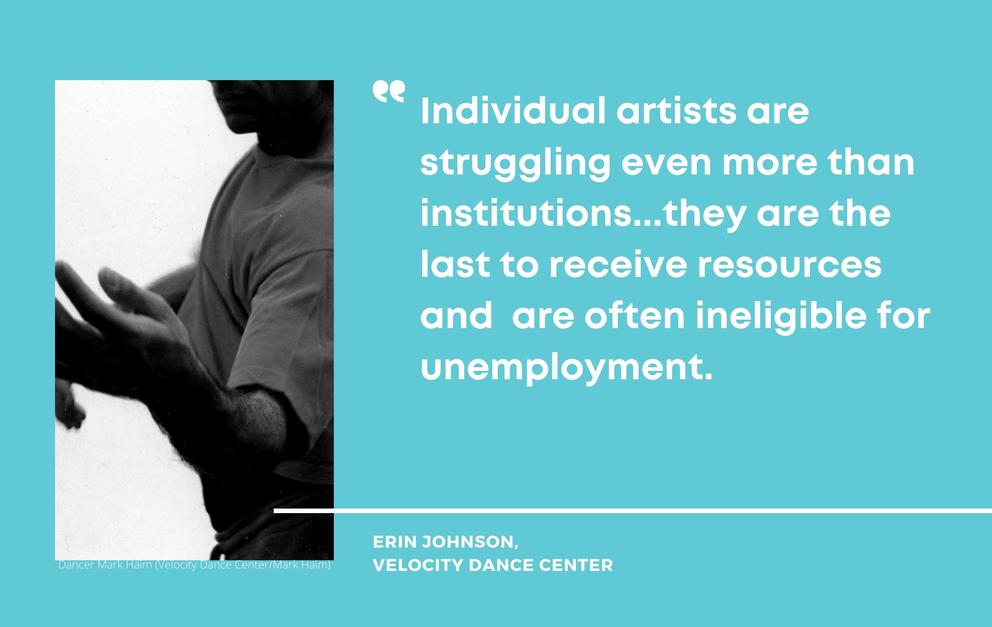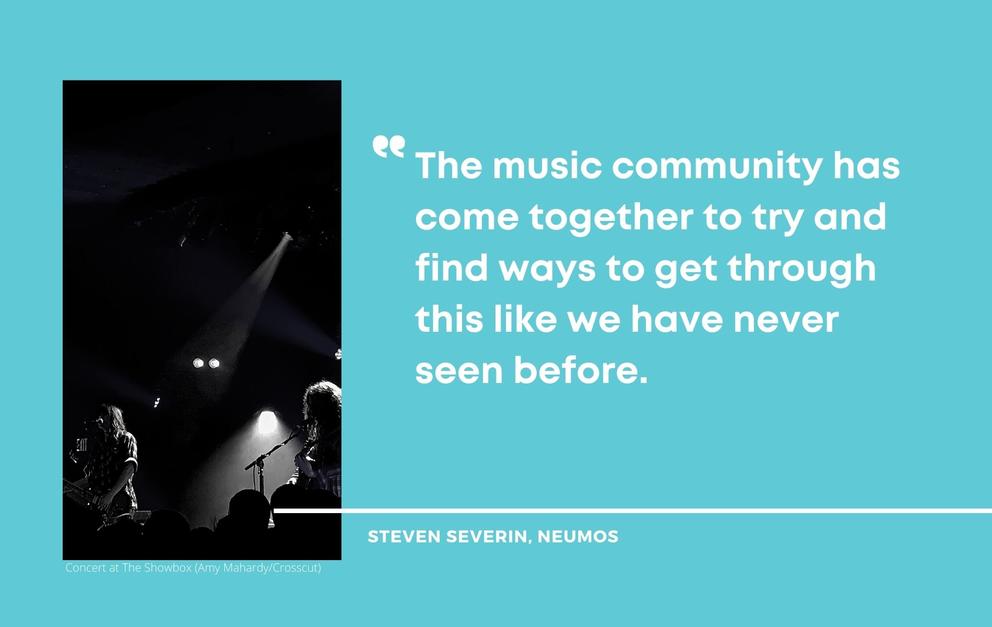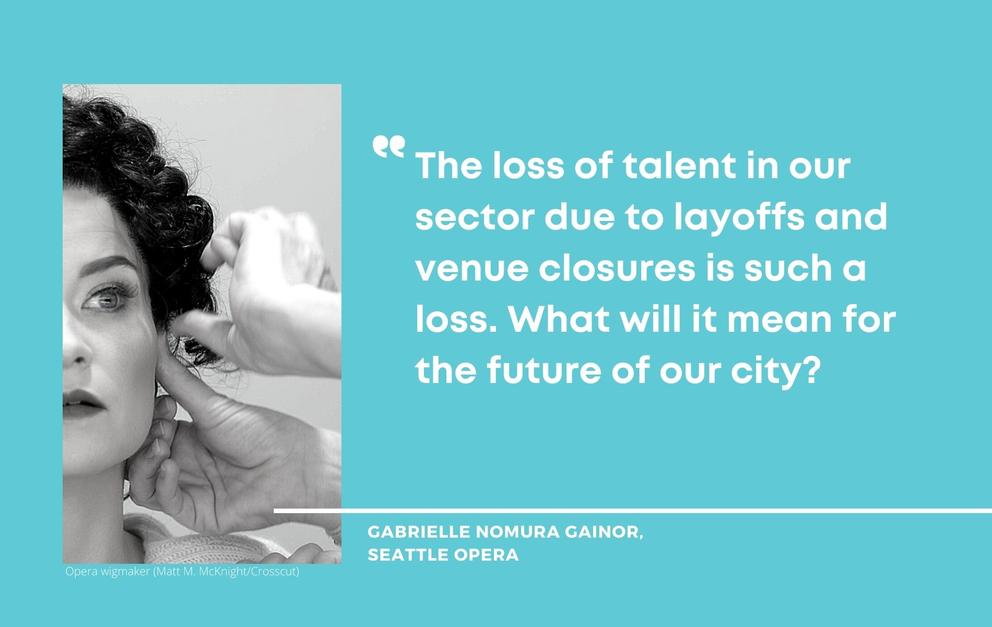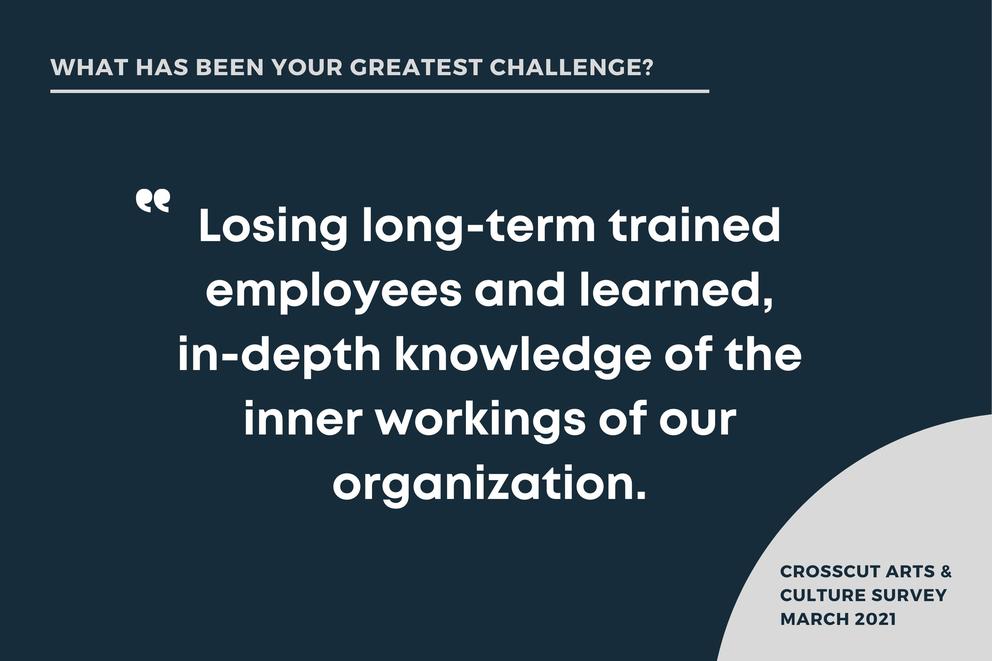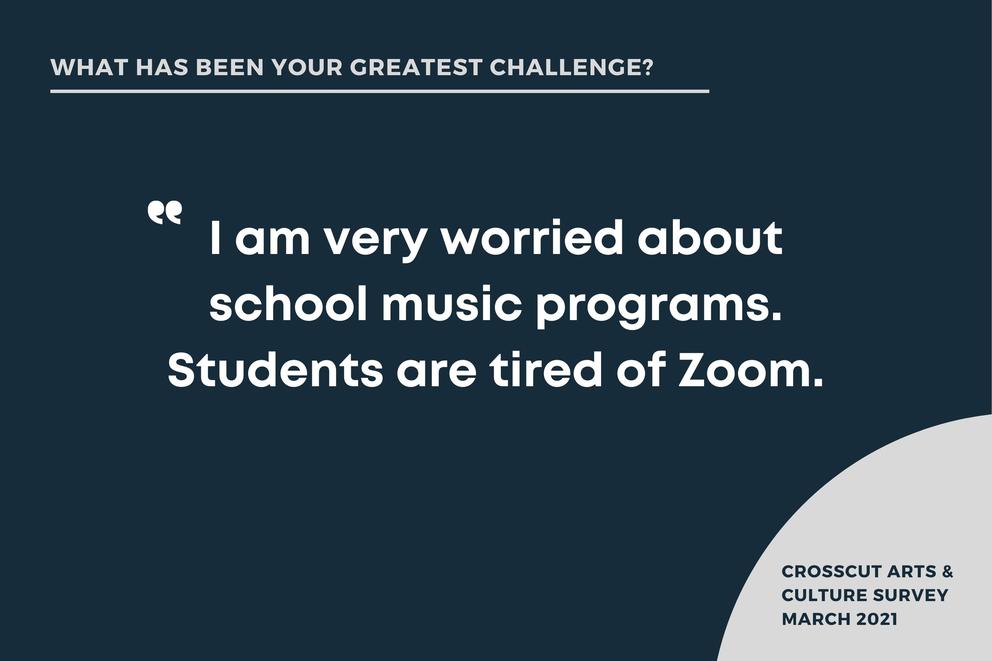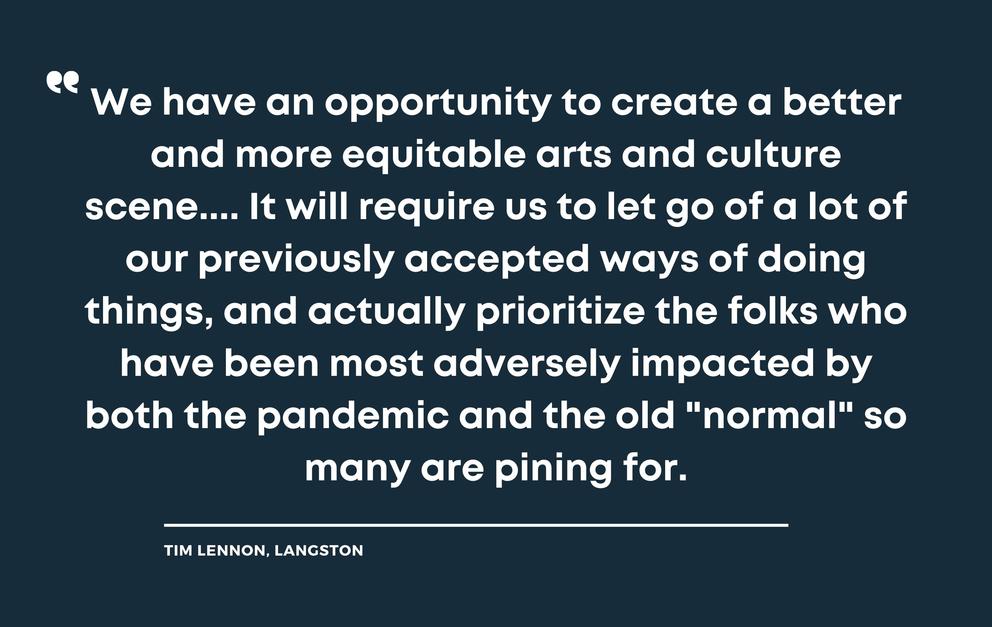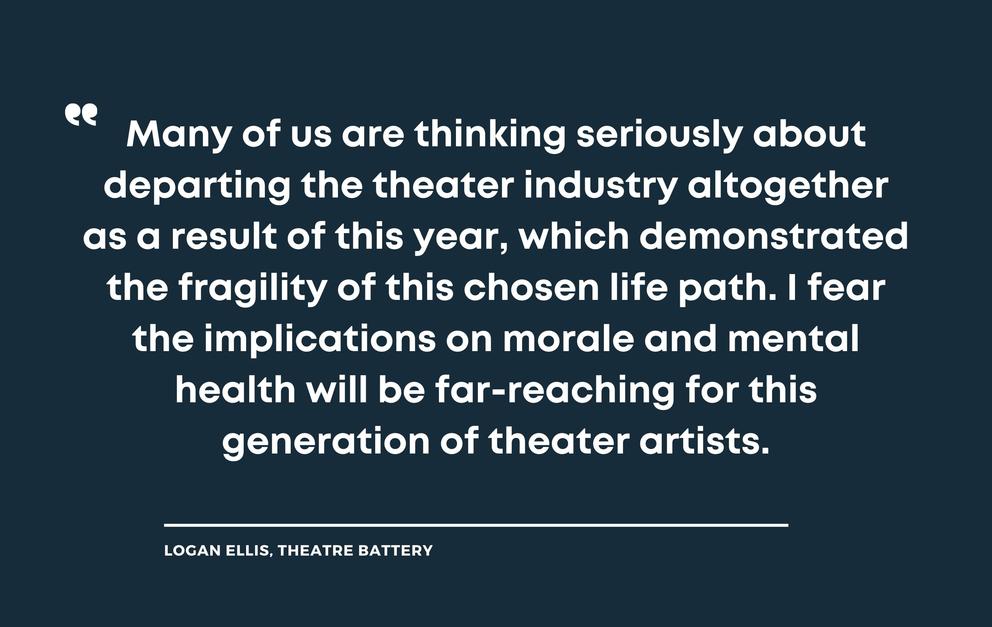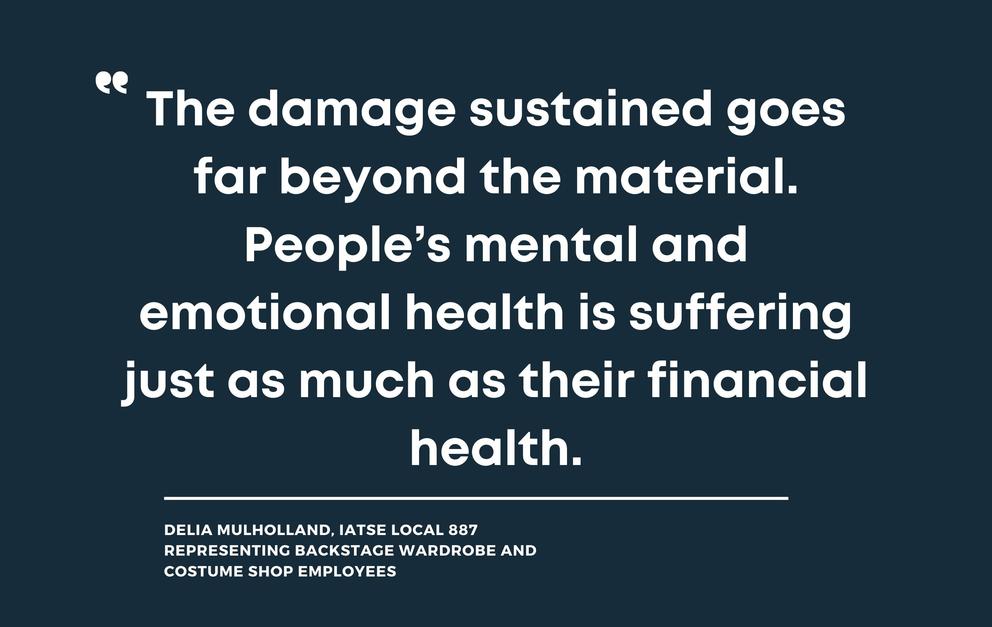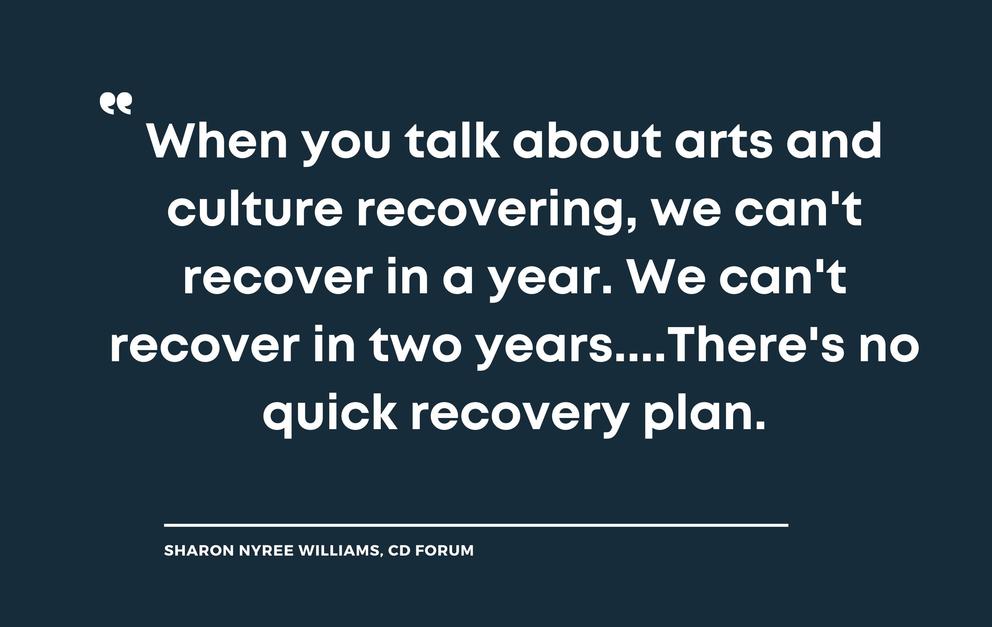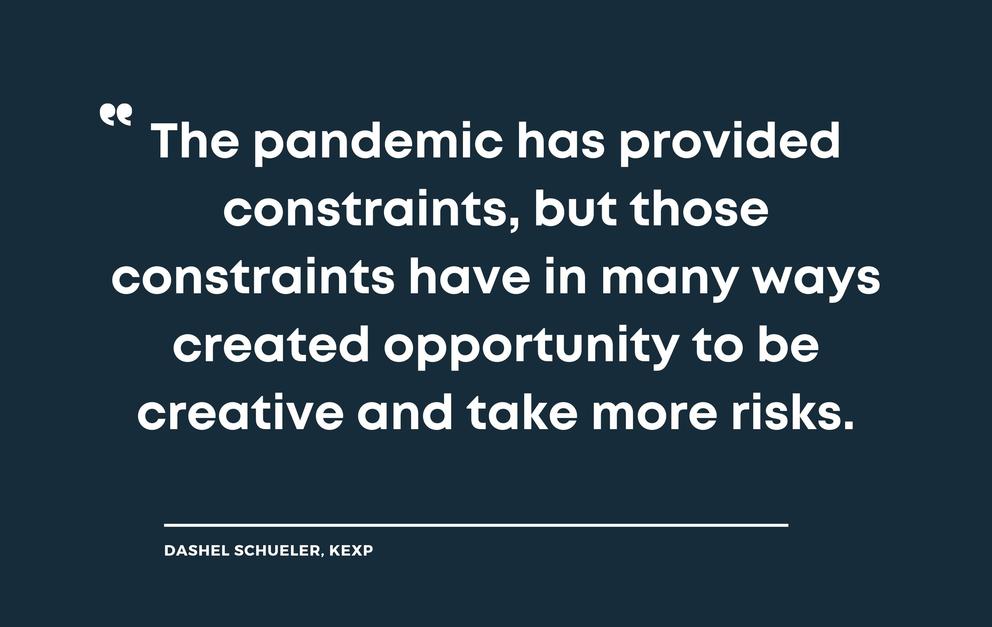Alley-Barnes had just celebrated her first exhibition as the incoming executive director of Pioneer Square gallery Center on Contemporary Art, a local arts organization that has been around for 40 years. The March 7 Art Walk had been a success. More than 700 people passed through the 900-square-foot gallery to see CoCA’s annual member show, named (perhaps unfortunately) 20/20 Vision.
“On Thursday of the following week, we were shuttered,” Alley-Barnes says. The team moved the exhibit to the gallery’s website. “I came aboard as a new executive director for brick and mortar,” she adds. “And within two or three weeks, I was the executive director of online virtual reality.”
Alley-Barnes was right: art wasn’t canceled, at least not forever. But while her determination hasn’t waned, she’s had to readjust her expectations. “I was thinking in terms of a sprint,” she says. “I had no idea it would be a marathon.”
Strapped for cash
At the one-year anniversary of the first bans on gatherings, Crosscut wanted to check in with local arts and culture organizations: Is the finish line in sight? Who fears they won’t make it across? And how did the course change?
We reached out to Puget Sound-area cultural organizations with a survey about the challenges (and opportunities) of 2020 and the year ahead. We hoped to get a better sense of the havoc the pandemic has wreaked and learn more about the challenges, creative pivots and hopes for a post-pandemic cultural scene.
We received 142 responses. After weeding out duplicates and nonvalid entries, our sample size includes 125 organizations, hailing from Tacoma to Edmonds and including a wide variety of cultural organizations, from scrappy, volunteer-run theaters to major Seattle museums.
One troubling data point emerged: Cash balances are running low. The majority (72%) of respondents say they don’t have enough cash on hand to cover operating expenses for the next 12 months. About a quarter of respondents indicated their cash balance would only get them through two to three more months. Just over half said they have less than 7 months cash left.
One of these cash-strapped organizations is Velocity Dance Center, a 25-year-old dance institution that had to leave its Capitol Hill location in December. The organization couldn’t afford rent after revenue from in-person classes and shows vanished almost overnight.
“This pandemic has shown us just how vulnerable the arts are,” says Erin Johnson, Velocity’s interim artistic and managing director. Johnson points out that much of that vulnerability is “held by artists, specifically those who do not have the safety net of generational wealth.”
But, like many other small arts organizations, Velocity didn’t have a safety net or an endowment either, and had been struggling financially before the pandemic.
“We were operating on thin margins to begin with, with less than three months of cash reserves,” Johnson says. The pandemic was a shock the organization couldn’t absorb. Now in hibernation mode and without a home, Velocity can barely cover operating expenses for another month with its current cash reserve. Johnson says donors and funders are pitching in and she’s hopeful that more federal and local grant money, as well as future fundraising, may tide them over.
Swan-diving revenues
Like Johnson, many organizational leaders are pinning their hopes on more federal relief funds, including another round of Paycheck Protection Program loans, as well as the long-awaited Shuttered Venue Operators Grant, which has yet to open for applications. The clock is ticking, respondents said.
“If the government doesn't hurry up with the SVO grants, it’s going to be a rough year with a lot of venues closing,” noted one music venue owner in the survey.
Even if the grant application system opens right now, waiting until these are processed and distributed will take time, warns Hunter Motto, talent buyer at The Crocodile — and reserves are running dangerously low at performance venues across the board. In the past year, the legendary Belltown music venue has seen its revenue swan dive by 99%, Motto says.
Among the arts and cultural organizations surveyed, music venues have seen the most dramatic drop in revenue, 89% on average, followed by other performing arts venues and organizations, whose revenue halved on average.
But unlike other types of arts organizations, The Crocodile hasn’t invested much in streaming as a revenue model — reflecting another trend that emerged among surveyed music venues. Creating good digital music programming is expensive and hazardous in a pandemic, Motto points out, because you need multiple people in the same room together. “For many performers and venues, streaming doesn’t generate enough revenue to be worth the risk,” he says. “The national-scale streaming model during COVID has mostly moved to artists recording one performance, and venues across the country promoting that performance.”
Most other arts organizations did take the digital plunge, with 85% reporting that they “pivoted” traditional programming to live and/or prerecorded online events, concerts and fundraisers. Many did so with relative success. Several indicated that going digital has helped expand their audience numerically and geographically.
For the National Nordic Museum, this meant that the virtual “Nordic Innovation Summit” last May reached thousands of people across 19 countries, a first for the 41-year-old museum. Going digital allowed Central District arts center LANGSTON to (re)connect with “folks who were displaced from our neighborhood and now live in the exurbs,” says executive director Tim Lennon. “Before the pandemic, the commute to our venue was a barrier to access.”
While not a financial saving grace — or a replacement for the magic of a live experience — this newfound accessibility has been so positive that many envision a hybrid online/IRL model going forward.
Still, some have tried to maintain the magic of the live experience by moving the art to a safer environment: outdoors. KEXP DJ John Richards invited musicians to perform live on air during “Lawn in the Morning” shows from his yard, and over the summer, dancers from local company Whim W’Him populated local parks with moving pop-up performances.
Others, like Bill Gaylord of Chinatown-International District gallery BONFIRE, pivoted by transforming their closed exhibit venues into free spaces for making art (an option in short supply even pre-pandemic). “In one case, a costume designer took over the gallery space and brought a sewing machine and fabrics to create a studio to make custom artist masks to sell, since they lost both of their jobs in theater costume and the hospitality industry,” Gaylord says.
Sufficient space was the issue for artists Nahaan and Ezra Dickinson, who now are using the back of Capitol Hill gallery/bar Vermillion (where people in the “beforetimes” drank and danced) to construct and paint a 19-foot long red cedar Haida-style canoe. Starting this month, Vermillion is also transforming its front gallery into a performance venue for a bi-monthly series of book readings, poetry performances and acoustic acts called “Artists behind glass.” The audience will be able to watch from the sidewalk as masked artists perform in the window. And in Pioneer Square, SOIL gallery transformed its digs into a studio for art residencies and, most recently, a film set.
Educating the next generation of artists
While valuable, many pivots never quite rose to the crucial challenge: covering paychecks and rent. The push and pull of staggered reopening plans and varying guidelines only complicated this. Whether they called it “topsy-turvy” or “planning with guesses” or “changing rules,” respondents indicated that the uncertainty made planning — and budgeting — more difficult.
While survey respondents indicated that mental health is an overall challenge, Klair Ethridge of Tacoma Urban Performing Arts Center, or T.U.P.A.C., which offers ballet and dance classes to children, worries most about student morale and Zoom fatigue. “Our students are burned out from being online all day; they study their academics, have a short break and return to their computers for dance instruction in the evening,” she says.
Educational arts organizations like T.U.P.A.C. have been struck hard by the pandemic, and navigating regulations proved a particular challenge. “We have not received a clear set of guidelines,” one respondent said, noting that guidelines for performing arts in schools and the performing arts as a sector do not align. “We seem to fall between the cracks.”
One respondent voiced concern about arts losing emphasis as students go back to in-person learning: “This next school year, administrators will be so caught up in addressing pandemic learning loss that it will limit access to arts education.”
Art schools and educational art organizations reported a 46% drop in revenue in the past year, making them harder hit than museums, galleries and cultural centers that responded to the survey.
That’s in part because museums have been able to reopen (twice) in the past 12 months. And galleries, categorized as retail, have been open since this past summer. A few galleries even reported an increase in sales last year. “More people are buying art,” one gallerist told me. “I never closed the gallery, instead I went to a by-appointment schedule....I continued rotating my exhibits and folks seem to appreciate art and the ability to see it even more in this time than before. The private visits are more personal and perhaps more meaningful for both myself and our visitors.”
Many art collectors are spending more time inside and want to add new pieces of art to their home, another gallerist told me. And yet another gallery owner offered this explanation for the increase (or steady continuation) of sales: “I think it’s because people are reassessing their values…. I think everyone has realized how crucial the arts are.”
The impact of BLM protests
Another not-so-straightforward picture emerges when zooming in on survey respondents who indicated they didn’t see a reduction in revenue last year (a small subset, 17 out of 125). Remarkable: 41% of those 17 organizations self-identified as Black-, Indigenous- or people of color-centered, even though these organizations represent just 17% of the overall survey respondents.
This is in part due to the relative financial windfall of a few BIPOC organizations who saw an influx of donations last year.
“We did raise significantly more money in 2020,” Elisheba Johnson of Wa Na Wari noted. “But we think a lot of that was a result of the Black Lives Matter movement making white people give money. But perhaps they only gave that one time? Time will tell.”
The Central District Forum for Arts and Ideas, which presents Black artists, stories and experiences, also saw its revenue jump, due to a sizeable corporate donation (from a San Francisco-based company with Bellevue offices), as well as more general donations overall. “The love that we have been shown because we are a Black organization has been good,” executive director Sharon Nyree Williams notes in the survey. “The concern is that the love won’t continue because the moment/movement will be over for non-Black supporters.”
“As an organization, I can’t get comfortable,” she told me during a recent Zoom call. “I’m, like, scared. How do we hold on to this? How do we duplicate this if the social unrest isn’t happening?”
Central District arts nonprofit LANGSTON saw its revenue double, due to a fundraising plan put in place years ago, as well as more recognition for the organization as it helped distribute the Seattle Artists Relief Fund this past year. But executive director Tim Lennon cautions against getting too cheery about these unusual and exceptional numbers. “The last thing I want to do is have our org’s relative success make folks think that the situation isn’t dire for all of us, ‘cause it is.”
For the arts sector, the Black Lives Matter protests had an impact beyond donations. Multiple survey respondents noted that the pandemic hiatus also allowed them more time to work on long-overdue anti-racism work and diversity, equity and inclusion plans.
While shifting programming because of the pandemic proved a challenge, one major Seattle organization wrote, “I think the internal work to confront and … move toward a more meaningful and holistic commitment to anti-racism has presented the most significant challenge for our organization — as well as the most significant opportunity to grow and serve our community more fully.”
Multiple organizations also indicated that the pandemic hiatus allowed them a chance to rethink their overall mission, overhaul long-standing ways of working and make programs more accessible. These included redesigning websites and newsletters, increasing fundraising efforts, consolidating programs, as well as making physical changes like facility upgrades and making venues more accessible to people with disabilities.
Another silver lining emerging from the devastation, according to respondents: newfound solidarity. While money is low, organizations have pooled resources, offered up spaces to others free of charge and formed new partnerships, coalitions and working groups over Zoom to share gigs and resources, talk about unemployment issues or just commiserate.
“Coalitions of museums and cultural heritage organizations are coming together to solve common problems, brainstorm and collaborate,” said Andrea Godinez, public relations manager of the Burke Museum. “These types of collaborations have been immensely helpful and will likely continue well after the pandemic ends.”
From left, the leadership team of the Northwest Film Forum, executive director Vivian Hua, artistic director Rana San, and managing director Christopher Day. The organization has made nearly all of its newly online programming available on a sliding scale basis. "What I hope... is that the landscape will change to grow more accessible all around," Day told Crosscut. (Dorothy Edwards/Crosscut)
Cautious optimism
Predicting when we’ll be “post-pandemic” — or what exactly that means — is still akin to reading tea leaves. Most performing arts organizations and music venues said they’re not putting much stock in 2021. Many don’t expect a reopening with new theater productions or music shows until the fall or later.
“I think it will be a long time, even after vaccines are available, before 300-plus people will want to sit shoulder to shoulder, in the dark,” one respondent wrote.
This is in part why more than a quarter of organizations expect revenue, along with membership and subscriptions, to further decline. A small subset (14%) responded they fear more layoffs or furloughs as well. One of them, an executive director who asked to remain anonymous, was planning to soon lay off one of the few remaining employees: herself.
But there’s also some good news: Only a small minority fears having to close their institution for good. And 54% of organizations feel more confident about 2021, expecting revenue to pick back up and/or to (re)hire this year.
This cautious optimism (or is it shell-shocked ambivalence?) is reflected in other numbers as well: people’s feelings about 2021 fall in between “despair” and “very positively excited,” but land on the positive side, an average of 6 on a scale of 1-10. Perhaps we should have included an option for “better than disastrous”?
Are we there yet?
Even if vaccine distribution speeds up, questions remain, says John Bradshaw, managing director of the Seattle Shakespeare Company. “The bigger unknown is when will people feel comfortable?” he asks. “I don't think people will simply plug back in. I think there will be people who come back, but I think there will certainly be people who are more reserved and will take their time.”
Like Bradshaw, many theater and music professionals expect the return to venues to be slow and gradual. “When the theaters do come back, they will certainly not be working at the capacity and at the amount of productions that they were pre-pandemic,” says Yasmine Kiss, stage manager at the Seattle Opera.
That means that there likely won’t be enough work to go around, at least not for a while. Kiss fears it’ll cause more people to leave the profession. Colleagues of Kiss have already departed for more secure jobs or gone back to school, she says. Her biweekly Zoom call with a group of national opera stage managers has dwindled because so many have left the industry. “And by doing that, they're beginning to leave holes,” she says.
Others in the performing arts fear a creative “brain drain” as the pandemic wears on. “We are definitely losing industry knowledge and experience,” says Delia Mulholland of IATSE Local 887, a union representing costume shop and backstage wardrobe employees in Western Washington. “This will have the biggest impact on costume shops, where costumers cultivate their skills over decades.”
But, both Kiss and Mulholland stress, it was tough patching together jobs and working long hours to make a living in the sector, even pre-pandemic. Industry professionals are now reassessing this, Kiss says. “People are coming together and saying, why do we work six days a week? Why do we have these two days when we’re in the tech process and the theater that we’re working 12 hours a day? Why is that sort of type of labor necessary to produce art?”
The hope, she says, would be that “companies can actually begin to turn around and look at things in a more humane way and say: What can we do to actually make this industry more sustainable in the future, where you’re not going to have that talent attrition, because maybe we’ll take some of these awful work rules and figure out better ways to do it.”
Preexisting conditions
Many in the field share the desire. If anything, respondents hope the pandemic has been a wake-up call for the general public and those in power: The brick house of the arts and culture industry needed retrofitting long before this earthquake took it down.
“The sector was struggling before all of this because investment in arts and culture in Washington state is low relative to other parts of the country,” says Ellen Walker, executive director of the Pacific Northwest Ballet. “And yet arts and culture generates 8.4% of the [state] GDP.”
During this crisis, many have stepped up to bolster teetering organizations with fast-tracked cash grants and direct financial support from governments, foundations and individuals, says Bradshaw of Seattle Shakespeare.
“We’re going to need to see that continue, that it wasn’t just a moment, but it’s a continuation as we recover and rebound,” he says. “I hope that there’s a recognition from everyone of the role the arts play in our lives… I think that the pandemic has raised that awareness, but it needs to be sustained.”
Though many expect recovery to be a process that takes years, some say the potential is there now to make long-overdue changes for a post-pandemic cultural scene — by investing in truly affordable and sustainable space for venues and artists.
“I strongly believe there is an opportunity ... to reconceptualize live events, nightlife and music and arts venues as publicly supported institutions (not just privately supported),” Motto of The Crocodile wrote in a survey comment. “This could apply to building ownership, like what Historic Seattle does, purchasing buildings as preservation and allowing community groups to operate them at stabilized rental prices.”
He hopes the city’s new Cultural Space Agency (which was created with these types of partnerships in mind) will also turn its attention to nightlife and collaboration with businesses that are not nonprofit entities.
Like Motto, Velocity's Johnson is also pinning some of her hopes on the Cultural Space Agency, “so that small arts and culture organizations can have help making their physical locations sustainable places,” she says. She also hopes COVID relief grants and the Shuttered Vendor Operators Grant indicate a shift toward more — and more sustained — governmental support for art organizations. And, she adds: “For individual artists, maybe the pandemic can help us find new pathways like UBI [Universal Basic Income] or some kind of safety net for artists to have ongoing support.”
The arts and culture industry has relied on old models and underpaid, overworked people for decades. Those models weren’t cutting it even pre-pandemic, says LANGSTON’s Lennon. “The old ways were not that great for a lot of small organizations, artists and culture workers, especially those from BIPOC communities,” he wrote.
Royal Alley-Barnes — who’s had a decadeslong career in the local art scene — couldn’t agree more. “One of the [things] I hate to hear is that ‘hopefully things will go back to normal.’ No, normal was horrific for so many people. Normal was horrific for the general population of artists,” she says.
Although unfortunate that it took a pandemic and protests against institutional racism to imagine a new, better way forward for everyone, Alley-Barnes says now’s the time for what she calls transformative change, a complete overhaul. As she noted in the survey: “The Seattle arts landscape has not had any significant changes in more than a quarter of a century.”
Over the course of her career, she says she’s seen many starts and stops of promised change that never really materialized. Nevertheless, Alley-Barnes says there’s cause for optimism, such as private and governmental granting organizations implementing more equitable funding models, and the many artists and grassroots organizations finding ways to innovate.
“As I said earlier, art is not only not canceled, art is changing. Art is a change agent. It’s a catalyst, and I am extremely [excited] to see it move forward,” she says. “To see all these people come together and make that change.”
Get the latest in local arts and culture
This weekly newsletter brings arts news and cultural events straight to your inbox.



